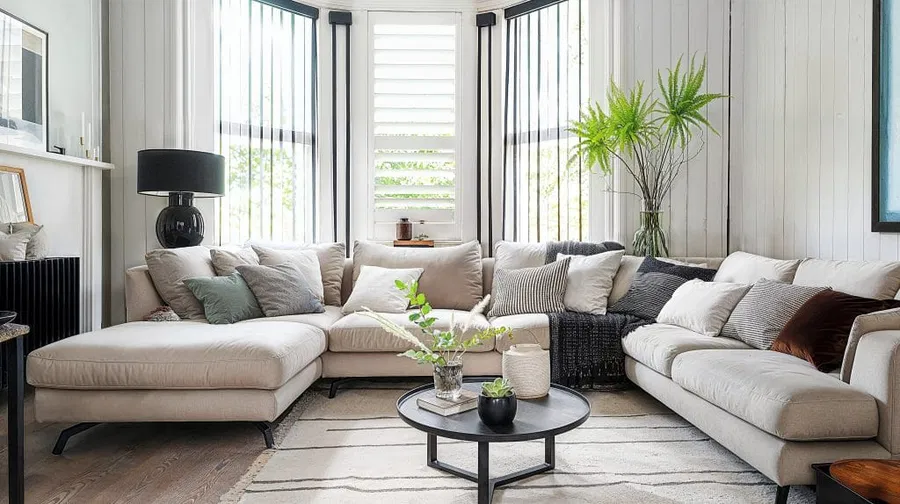Creating a stylish, comfortable space in a compact home can feel challenging, but modern minimalism offers a beautiful path forward. Clean lines, intentional décor, and thoughtful furniture choices can transform even the smallest room into an inviting retreat. As homeowners continue to search for small living room ideas that feel both practical and sophisticated, minimalism has become a favorite approach for its ability to make a room look lighter, calmer, and more spacious without sacrificing personality. This design philosophy encourages simplicity, clarity, and harmony—three qualities that small homes benefit from the most.
Start With a Neutral, Calming Foundation
Minimalism begins with the backdrop of the room: your walls, floors, and core color palette. A neutral foundation helps the space breathe and allows your furniture and décor to stand out without overwhelming the eye. Soft whites, warm creams, muted greys, and gentle earth tones create a calming visual rhythm, especially in smaller rooms. This kind of palette allows light to travel more freely across the space, making the room feel naturally larger. Designers often emphasize the power of understated tones when exploring small living room ideas, because they make it easier to layer textures and create depth without clutter. Light wood flooring, textured rugs, linen curtains, and ceramic accents all enhance this clean, foundational look.
Choose Streamlined, Modern Furniture
The furniture you choose can completely reshape how a small room feels. Heavy, oversized pieces immediately shrink a space, while slim, low-profile furniture opens it up. Look for sofas with visible legs, which introduce an airy feeling. Avoid bulky armrests and deep seats if your space is limited; instead, choose pieces with clean shapes and simple frames. Multifunctional furniture is also incredibly useful—storage ottomans, nesting tables, and convertible seating allow you to adapt the room based on your daily needs. Many professional designers highlight small living room ideas that incorporate furniture with curved edges or soft, rounded corners, since they make movement easier and reduce visual heaviness. Functionality and elegance should work together rather than compete.
Use Layouts That Support Natural Flow
Even the best furniture won’t shine if the layout is poor. In small living rooms, the layout determines how spacious or tight the area feels. Instead of pushing everything against the walls, try floating your sofa slightly inward to establish a central gathering zone. Use a rug to anchor the seating area, making the room feel more structured and intentional. Modular furniture is especially helpful because it allows you to rearrange pieces depending on your activities—hosting guests, relaxing after work, or creating a cozy reading corner. When researching small living room ideas, many interior experts highlight the importance of clear walking paths and open sightlines. These details physically and visually enlarge the room, creating a more welcoming atmosphere.
Keep Surfaces Clean and Clutter-Free
Minimalism embraces the idea that less is often more. Clutter creates visual stress, especially in small rooms, making the space feel crowded. Keeping surfaces clean—like coffee tables, media units, and shelves—helps maintain a peaceful environment. This doesn’t mean avoiding décor entirely; it simply means using it with intention. Instead of multiple small items, choose one or two standout pieces such as a ceramic vase, a sculptural candle holder, or a framed print you love. Hidden storage plays a major role here. Smooth-front cabinets, woven baskets, and minimalist wall units help you stash everyday items without breaking the clean aesthetic. A tidy space communicates calmness, which is at the heart of almost all small living room ideas.
Add Height and Interest With Vertical Touches
When your floor space is limited, your walls become valuable design opportunities. Vertical elements draw the eye upward, adding a sense of height and dimension. Floating shelves, slim bookcases, tall houseplants, and elongated artwork all help create visual lift. Mirrors are especially effective in small rooms—they reflect light, expand the perceived space, and bring a polished look to the room. A tall mirror placed opposite a window can double the natural light in your living room. These vertical design techniques are often recommended in expert-approved small living room ideas because they balance the horizontal footprint of furniture and allow small rooms to feel more dynamic.

Use Light to Expand the Atmosphere
Lighting is often overlooked, but it plays a pivotal role in shaping the feeling of a room. Relying solely on overhead lighting can create harsh shadows and flatten the space. Layered lighting—think floor lamps, wall sconces, table lamps, and even hidden LED strips—adds warmth, depth, and visual comfort. Choose lighting fixtures with slim silhouettes or simple shapes to stay true to the minimalist aesthetic. Natural light is equally important. Replace heavy drapes with sheer curtains or light-filtering shades to brighten the room without sacrificing privacy. Studies on interior psychology consistently show that soft, natural light can make small rooms feel significantly larger and more inviting.
Embrace Minimalist Decor With Meaning
Minimalist décor doesn’t mean lack of personality—it means intentionality. Choose pieces that genuinely enhance the look and feel of your living room. A single statement artwork, a textured throw, or a handcrafted ceramic bowl can serve as a focal point without cluttering the space. Textures add warmth where color remains subtle. Wool, linen, boucle, natural fibers, and unfinished woods create inviting contrast without overwhelming the minimal aesthetic. Avoid overly busy patterns; instead, lean into soft geometric shapes or subtle stripes if you want visual interest without chaos. The key is balance—expressing your style while keeping the room breathable.
Decorate With Natural Materials
Natural elements bring a sense of grounding and comfort to small, modern spaces. Wood, stone, rattan, jute, cotton, and clay add texture, warmth, and authenticity. Scandinavian and Japanese design traditions, which heavily influence modern minimalism, both rely on organic materials to soften the sharpness of minimal interiors. A wood coffee table, a woven chair, or a ceramic planter introduces a timeless aesthetic that pairs well with the calming neutral palette. These pieces are not just decorative—they help create a living room that feels peaceful, connected, and welcoming.
Invest in Smart Storage Solutions
Storage is one of the most essential components of designing a functional small living room. Built-in shelving, wall-mounted units, and low-profile storage cabinets help maintain order without dominating the space. Storage ottomans, benches with hidden compartments, and media consoles with interior drawers keep everyday essentials out of sight. Good storage prevents clutter from accumulating, which helps maintain the visual serenity that minimalist design is known for. When everything has a proper place, it becomes easier to keep the room looking polished and peaceful.
Keep Technology Clean and Minimal
Modern homes rely on technology, but that doesn’t mean cords and devices should be on full display. Wall-mounted TVs free up floor space and create a sleek, modern profile. Cable-hiding systems and slim media units help manage electronics without creating an eyesore. Many people also integrate smart home solutions with subtle lighting controls or compact speakers to maintain a clean look. When technology blends seamlessly into the design, the room feels polished rather than busy.
Conclusion
A modern, minimalist approach brings clarity, balance, and style to compact living spaces. By using intentional furniture choices, thoughtful layouts, natural materials, and clean design principles, even the smallest rooms can feel open, warm, and functional. The best small living room ideas are those that embrace simplicity while still making room for personality. When you focus on what truly matters—comfort, functionality, and harmony—you create a living space that feels peaceful and inspiring every day. Minimalism isn’t about doing less; it’s about doing more with what you have, and making your home a place where calm and beauty naturally come together.
How do I make a small living room feel bigger?
Use light colors, slim furniture, and open pathways. Mirrors and natural light also help expand the room visually without major renovations.
What furniture works best in a minimal small living room?
Choose pieces with clean lines, visible legs, and compact shapes. Multifunctional furniture like storage ottomans or nesting tables adds practicality without clutter.
How can I decorate without overcrowding the room?
Focus on a few meaningful pieces such as one large artwork, a textured throw, or a single decorative vase. Intentional décor keeps the room inviting without feeling busy.
Is it possible to add storage without making the room look packed?
Yes. Use hidden storage like cabinets, benches with compartments, or wall-mounted shelves. These solutions keep items organized while maintaining a clean aesthetic.




